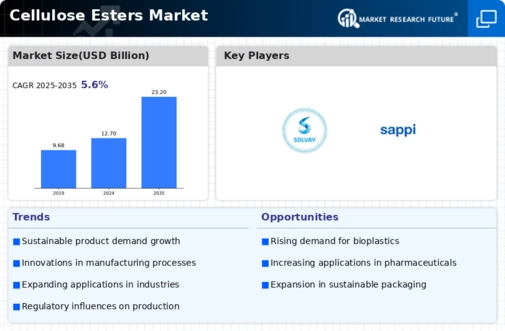Top Industry Leaders in the Cellulose Esters Market

The cellulose esters market growth can be attributed to the versatility and unique properties of cellulose esters, which find applications in diverse industries ranging from coatings and films to pharmaceuticals and cigarette filters. However, the competitive landscape of this market is complex, with established players vying for market share alongside niche players seeking to carve out their own space.
Strategies Shaping the Market:
Product Differentiation: Leading players like Eastman Chemical Company and Solvay are focusing on developing new and improved cellulose ester grades with enhanced performance characteristics, catering to specific end-use applications. For instance, Eastman's cellulose acetate propionate (CAP) offerings cater to the growing demand for sustainable packaging solutions in the food and beverage industry.
Geographic Expansion: Emerging markets in Asia Pacific, particularly China and India, are witnessing a surge in demand due to their booming automotive and construction sectors. Established players are strategically expanding their production capacities and distribution networks in these regions to capture market share.
Vertical Integration: Integrating backward into pulp production and forward into downstream applications like film and filter manufacturing provides greater control over the supply chain and cost optimization, enhancing competitiveness.
Sustainability Initiatives: The increasing focus on environmental sustainability is driving demand for bio-based and biodegradable cellulose esters. Companies are investing in research and development to create cellulose esters derived from renewable resources like wood pulp and bamboo, offering eco-friendly alternatives to traditional petroleum-based plastics.
Mergers and Acquisitions: Consolidation through mergers and acquisitions is another prevalent strategy. In 2022, Celanese Corporation acquired the cellulose acetate business of Daicel Corporation, strengthening its position in the global market.
Factors Influencing Market Share:
Brand Recognition: Established players with strong brand recognition and established customer relationships hold a significant advantage in capturing market share.
Technological Advancements: Continuous innovation in cellulose ester technology, leading to the development of new grades with improved properties, can propel a company ahead of the competition.
Production Capacity and Cost Efficiency: Efficient production processes and optimized supply chains can significantly impact cost competitiveness, attracting price-sensitive customers.
Regulatory Compliance: Stringent regulations governing the production and use of cellulose esters, particularly in the pharmaceutical and food industries, require companies to invest heavily in compliance measures, impacting their profitability.
List of Key Players in the Cellulose Esters Market:
- Solvay (Belgium)
- China National Tobacco Corporation (China)
- Celanese Corporation (US)
- Sappi (South Africa)
- Daicel Corporation (Japan)
- Eastman Chemical Company (US)
- Acordis Cellulostic Fibers (Germany)
- Rayonier Advanced Materials (US)
- Mitsubishi Chemical Holdings Corporation (Japan)
- Sichuan Push Acetati (China)
Recent Developments:
December 2023: Mitsubishi Chemical Holdings Corporation announced plans to invest in a new cellulose acetate plant in Thailand, catering to the growing demand in Southeast Asia.
November 2023: Sappi announced the development of a new cellulose acetate trimellitate (CAT) grade with superior flame retardancy properties, targeting the electronics and construction industries.
October 2023: Rayonier Advanced Materials launched a new line of cellulose nitrate films with enhanced toughness and flexibility, aimed at the medical device market.
September 2023: The Chinese government announced new regulations on the use of cellulose esters in food and beverage packaging, raising concerns about potential market disruptions.
August 2023: A fire at a cellulose acetate plant in China resulted in production disruptions and temporary supply chain challenges for the global market.

